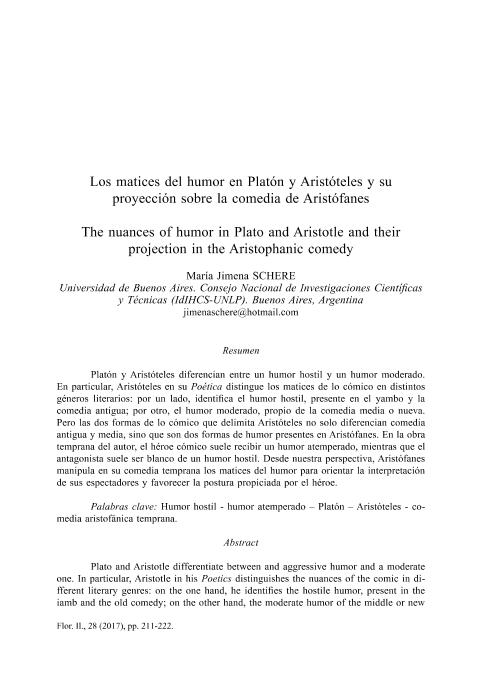Mostrar el registro sencillo del ítem
dc.contributor.author
Schere, María Jimena

dc.date.available
2018-10-02T14:54:57Z
dc.date.issued
2017-10
dc.identifier.citation
Schere, María Jimena; Los matices del humor en Platón y Aristóteles y su proyección sobre la comedia de Aristófanes; Universidad de Granada; Florentia Iliberritana; 28; 10-2017; 211-222
dc.identifier.issn
1131-8848
dc.identifier.uri
http://hdl.handle.net/11336/61489
dc.description.abstract
Platón y Aristóteles diferencian entre un humor hostil y un humor moderado. En particular, Aristóteles en su Poética distingue los matices de lo cómico en distintos géneros literarios: por un lado, identifica el humor hostil, presente en el yambo y la comedia antigua; por otro, el humor moderado, propio de la comedia media o nueva. Pero las dos formas de lo cómico que delimita Aristóteles no solo diferencian comedia antigua y media, sino que son dos formas de humor presentes en Aristófanes. En la obra temprana del autor, el héroe cómico suele recibir un humor atemperado, mientras que el antagonista suele ser blanco de un humor hostil. Desde nuestra perspectiva, Aristófanes manipula en su comedia temprana los matices del humor para orientar la interpretación de sus espectadores y favorecer la postura propiciada por el héroe.
dc.description.abstract
Plato and Aristotle differentiate between and aggressive humor and a moderate one. In particular, Aristotle in his Poetics distinguishes the nuances of the comic in different literary genres: on the one hand, he identifies the hostile humor, present in the iamb and the old comedy; on the other hand, the moderate humor of the middle or new comedy. But the two forms of the comic that delimit Aristotle not only differentiate old and middle comedy, but are two forms of humor present in Aristophanes. In the early work of the author, the comic hero usually receives tempered humor, while the antagonist is usually the target of a hostile one. From our point of view, Aristophanes manipulates in his early comedy the nuances of humor to guide the interpretation of his spectators and favor the posture propitiated by the hero.
dc.format
application/pdf
dc.language.iso
spa
dc.publisher
Universidad de Granada
dc.rights
info:eu-repo/semantics/openAccess
dc.rights.uri
https://creativecommons.org/licenses/by-nc-nd/2.5/ar/
dc.subject
Humor Hostil
dc.subject
Platón
dc.subject
Aristóteles
dc.subject
Humor Atemperado
dc.subject
Comedia Aristofánica Temprana
dc.subject.classification
Estudios Generales del Lenguaje

dc.subject.classification
Lengua y Literatura

dc.subject.classification
HUMANIDADES

dc.title
Los matices del humor en Platón y Aristóteles y su proyección sobre la comedia de Aristófanes
dc.title
The nuances of humor in Plato and Aristotle and their projection in the Aristophanic comedy
dc.type
info:eu-repo/semantics/article
dc.type
info:ar-repo/semantics/artículo
dc.type
info:eu-repo/semantics/publishedVersion
dc.date.updated
2018-07-16T16:49:06Z
dc.journal.number
28
dc.journal.pagination
211-222
dc.journal.pais
España

dc.journal.ciudad
Granada
dc.description.fil
Fil: Schere, María Jimena. Consejo Nacional de Investigaciones Científicas y Técnicas. Centro Científico Tecnológico Conicet - La Plata. Instituto de Investigaciones en Humanidades y Ciencias Sociales. Universidad Nacional de La Plata. Facultad de Humanidades y Ciencias de la Educación. Instituto de Investigaciones en Humanidades y Ciencias Sociales; Argentina
dc.journal.title
Florentia Iliberritana
dc.relation.alternativeid
info:eu-repo/semantics/altIdentifier/url/http://revistaseug.ugr.es/index.php/florentia/article/view/6712
Archivos asociados
